A hand-washing station and bright yellow signs warning of an area of “high infection” now greet the steady stream of hearses at the entrance to the San Nicolas Tolentino cemetery in a working-class neighborhood of this sprawling metropolis.
Funeral parlors and crematoriums in Iztapalapa, a borough of 2 million people, are working day and night to manage the surging number of dead in the capital’s hardest-hit corner.
Concern is growing that mixed messages about the seriousness of the pandemic from Mexico’s president and lax enforcement of social distancing are manifesting in what could be a frightening preview as infections begin to peak in Mexico City and its suburbs — where some 20 million people live in close quarters, jamming subways and buses, shopping in crowded markets and clustering around street food stalls.
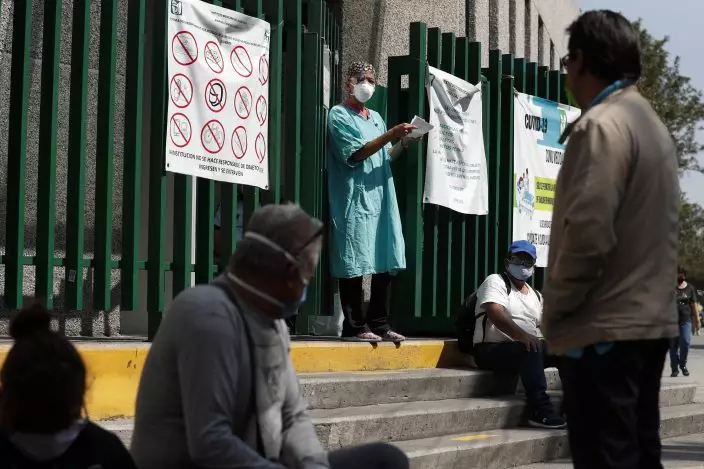
A hospital worker calls out a name from the gate, as relatives of hospitalized patients wait outside in hopes of receiving news of their loved ones, at a public hospital in the Iztapalapa district of Mexico City, Tuesday, May 5, 2020. Iztapalapa has the most confirmed cases of the new coronavirus within Mexico's densely populated capital, itself one of the hardest hit areas of the country with thousands of confirmed cases and around 500 deaths.(AP PhotoRebecca Blackwell)
On a recent morning, Rafael Hernández, who has sold tacos at the cemetery’s entrance for 40 years, said an average day before the pandemic might bring five or six hearses past his stand. “Today there have been 10 in an hour,” he said.
Rafael Herrera said in his 25 years working in the crematorium next door he's never seen anything like it. They’ve had to add another shift, and funeral parlors are calling for crematoriums like his to run their ovens run 24 hours a day as Mexico City recommends and pays for the cremations of coronavirus victims.
“We can’t keep up,” Herrera said. “We’re working from 6 in the morning to midnight.”

A man pushes a woman in a wheelchair as a dog walks alongside them, in the Iztapalapa district of Mexico City, Tuesday, May 5, 2020. Iztapalapa has the most confirmed cases of the new coronavirus within Mexico's densely populated capital, itself one of the hardest hit areas of the country, with thousands of confirmed cases and around 500 deaths.(AP PhotoRebecca Blackwell)
Behind that surging demand are personal tragedies. People are falling sick, dying and being cremated often before families receive test results if they come at all.
Erika, a 42-year-old lawyer, lost her mother two weeks ago, her brother is on a ventilator and her husband was admitted to the hospital Monday complaining of difficulty breathing. Her mother, who was diabetic, died two days after starting to feel ill and was cremated before a coronavirus test was performed. Her death certificate lists “respiratory insufficiency, atypical pneumonia, likely COVID-19.”
“The cruelest thing in all of this is not being able to honor or accompany your relative,” said Erika, referring to the traditional gatherings in homes that attract dozens or hundreds of mourners.

A man has his temperature taken by infrared thermometer as he enters the grounds of a government hospital, marked with signs announcing that the COVID-19 ward is full, in the Iztapalapa district of Mexico City, Tuesday, May 5, 2020. Mexico's densely populated capital is one of the hardest hit areas of the country, with thousands of confirmed cases, as well as many more suspected, and around 500 deaths.(AP PhotoRebecca Blackwell)
She is awaiting test results on her brother.
“I think what’s happening to me is happening to a lot of families,” said Erika, who didn't give her last name because she’s a criminal defense attorney and feared repercussions. She blamed a lack of early information from the government, saying that if the family had known her mother had the virus they would have taken more precautions. The family entered in a panic after her mother's death, but aside from her brother hasn’t been able to get tested and struggles to get information about hospitalized relatives.
“My father is devastated. He doesn’t sleep because of my brother. He doesn’t sleep because his wife just died. And yesterday in the time that my husband was admitted there were three deaths,” she said. Her father was rushed to the hospital Wednesday with a fever, but later released.
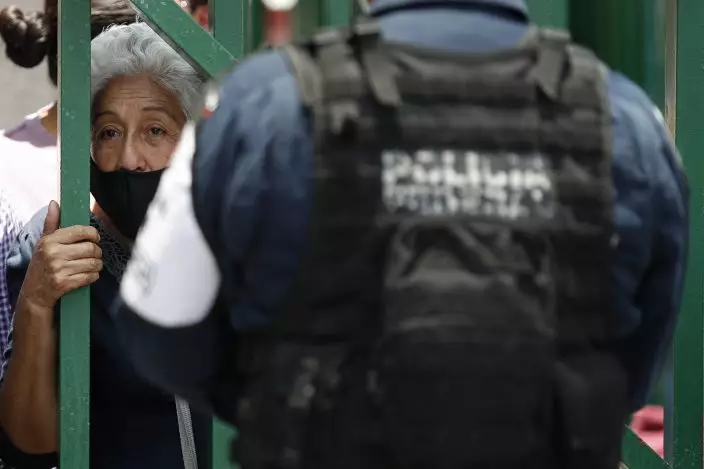
A woman peers through the gates of a public hospital treating both COVID-19 and other patients, as she tries to get information about a hospitalized loved one, in the Iztapalapa district of Mexico City, Tuesday, May 5, 2020. Iztapalapa has the most confirmed cases of the new coronavirus within Mexico's densely populated capital, itself one of the hardest hit areas of the country with thousands of confirmed cases and around 500 deaths.(AP PhotoRebecca Blackwell)
In Mexico City, there are more than 7,500 positive cases and more than 600 deaths — about a quarter of the national total — though health authorities concede the real number of infections is many times higher.
And authorities and experts agree the worst is yet to come.
“We have to prepare ourselves for the hardest, ugliest part,” said Dr. Mauricio Rodríguez, of Mexico’s National Autonomous University. There will be more hospitals filled to capacity and more deaths.
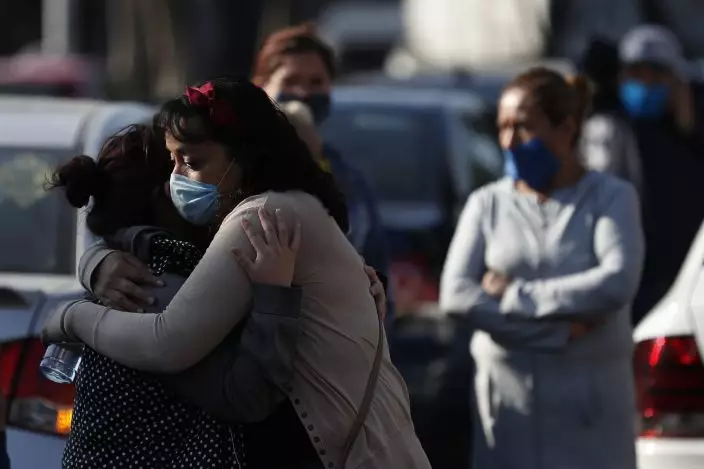
Family members of Gabriel Ulices Martinez Gutierrez, 38, who according to hospital staff is suspected to have died from complications of COVID-19, embrace outside San Nicolas Tolentino crematorium in the Iztapalapa district of Mexico City, Tuesday, May 5, 2020. Iztapalapa has the most confirmed cases of the new coronavirus within Mexico's densely populated capital, itself one of the hardest hit areas of the country with thousands of confirmed cases and around 500 deaths. (AP PhotoRebecca Blackwell)
Rodríguez said there was a certain “schizophrenia” in the political messaging, because at the same time the government is urging people to prepare for the epidemic’s peak, they’re talking about relaxing measures to satisfy economic sectors.
He emphasized, however, that from a public health perspective, it is crucial now for people in the most affected areas — the capital metro area first among them — to stay inside, and isolate themselves if they have symptoms. He reminded people the virus can seriously sicken someone in very little time and with hospitals overwhelmed there may be nowhere to take them.
Mexico has extremely limited testing compared to other countries, which makes experts believe the country's infections are much higher. Mexico City Mayor Claudia Sheinbaum said recently the city was performing only about 700 tests per day. The government has defended its limited testing of only people meeting a list of criteria, but it has left a growing number of families unsure of what killed their loved ones.
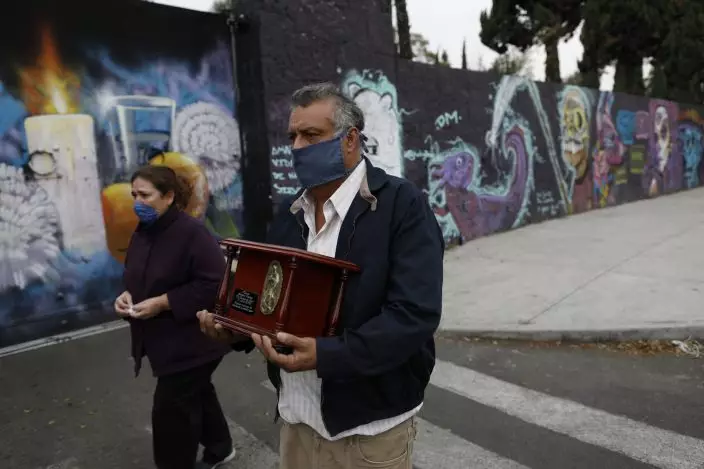
In this April 22, 2020 photo, Gustavo Briseno Garcia, accompanied by his wife Leticia Pinera Santana, carries the urn containing the ashes of his father, Manuel Briseno Espino, 78, who died from complications due to COVID-19, in the Iztapalapa district of Mexico City. Funeral homes and crematoriums in Iztapalapa, a working class borough of 2 million people, are working day and night to manage the surging number of dead by COVID-19 disease in the capital’s hardest hit corner. (AP PhotoRebecca Blackwell)
Guadalupe Gutiérrez’s 38-year-old son Gabriel Ulises Martínez was cremated this week with the family still uncertain of what he died from. She said he was hospitalized for 11 days with heart problems and flu-like symptoms but they were advised to cremate him because he might have had coronavirus.
The usually bustling streets of Iztapalapa are noticeably quieter these days. There is palpable worry, especially among the majority of its residents who can’t afford to stay home.
Among them is Christian Antonio Castillo, the 27-year-old cook in the kitchen of public hospital No. 47.
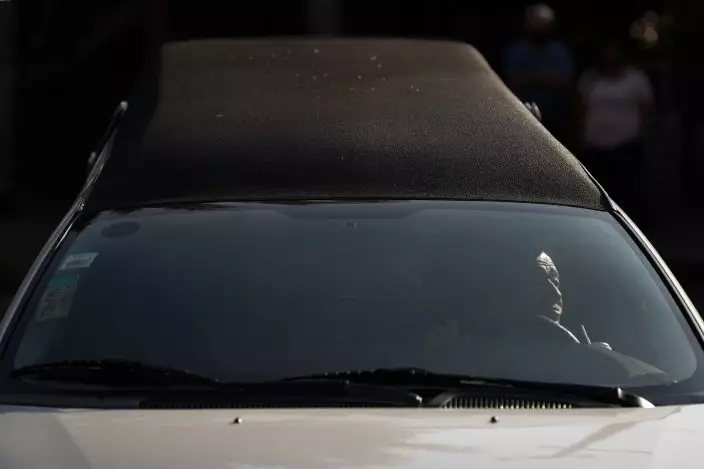
A funeral home driver maneuvers his hearse as he arrives at San Nicolas Tolentino cemetery and crematorium in the Iztapalapa district of Mexico City, Tuesday, May 5, 2020. Iztapalapa has the most confirmed cases of the new coronavirus within Mexico's densely populated capital, itself one of the hardest hit areas of the country with thousands of confirmed cases and around 500 deaths. (AP PhotoRebecca Blackwell)
When his father was admitted to his hospital with low oxygen levels, Castillo decided he should no longer sleep at home, where some 20 family members — nearly half of them diabetic — live together in a house with a shared kitchen and bathrooms.
Now Castillo sleeps in his car outside the hospital, next to a tent where anxious relatives wait day and night for word of their loved ones. As he spoke, three women cried together and another jumped when she heard her relative’s name called. Outside a nearby door, the hospital’s dead continued to exit one by one.
“I always thought I’d be the first to catch it,” Castillo said. “Now we’re all nervous, because the whole family was living with him,” he said of his father, who is on a ventilator with damaged lungs as the family awaits his test result.
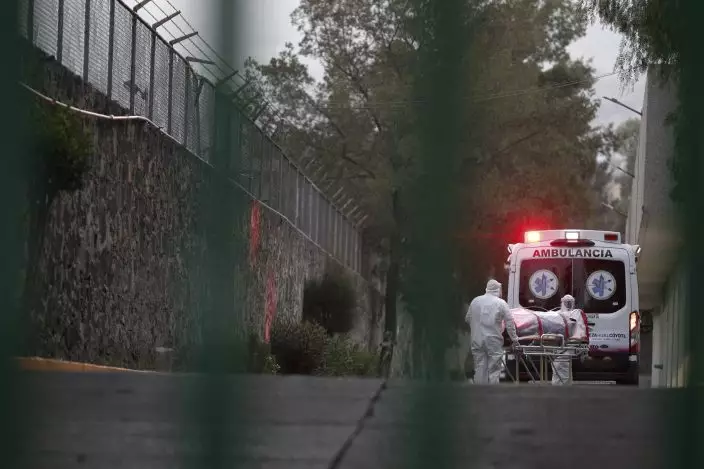
In this April 28, 2020 photo, ambulance workers unload a patient at a public hospital treating people with suspected COVID-19, in Iztapalapa, Mexico City. Concern is growing that early mixed messages about the seriousness of the pandemic from Mexico’s president and lax enforcement of social distancing, are manifesting in Iztapalapa first in what could be a frightening preview as infections begin to peak in the capital. (AP PhotoRebecca Blackwell)
“The test is the least of our worries,” he said. “I just pray this ends.”
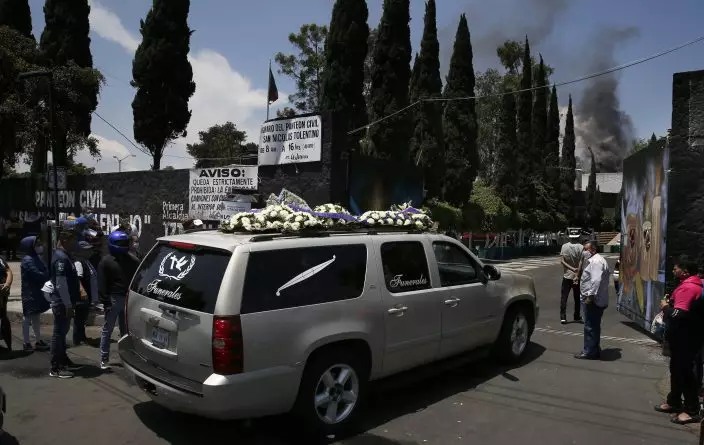
In this April 30, 2020 photo, a hearse enters the San Nicolas Tolentino cemetery and crematorium, as smoke rises from the crematorium in the background, in Iztapalapa, Mexico City. Funeral homes and crematoriums in Iztapalapa, a working class borough of 2 million people, are working day and night to manage the surging number of dead in the capital’s hardest hit corner. (AP PhotoMarco Ugarte)
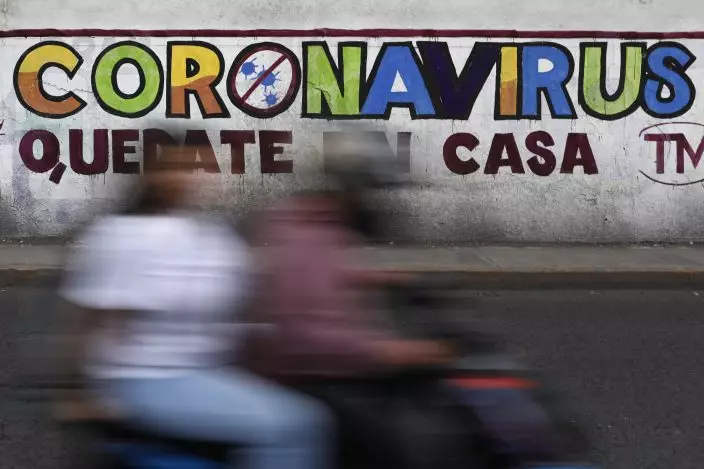
In this April 28, 2020 photo, a couple rides a motorcycle past a painted sign reading in Spanish "Coronavirus. Stay Home," in Iztapalapa, Mexico City. Mexico has had extremely limited testing compared with other countries, another factor that experts have said made it difficult for the country to contain the virus. (AP PhotoRebecca Blackwell)


